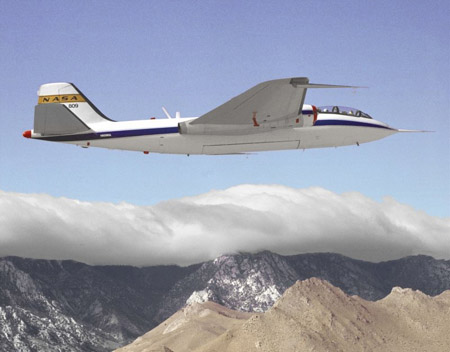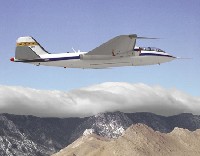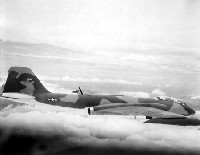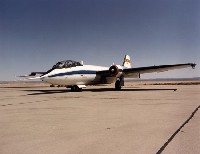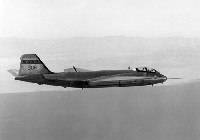Global Aircraft -- B-57 Canberra
|
Aviation Center
US Attack
US Bombers
US Cargo
US Fighters
US Helicopters
US Patrol/Pursuit
US Reconnaissance
US Tankers
US Trainers
US UAV's
US X Planes
Orbiter Vehicles
WWI Aircraft
WWII Aircraft
Airbus
Antonov
Boeing
Dassault
Ilyushin
Kamov
MiG
Mil
Saab
Sukhoi
Tupolev
Yakovlev
Joint/Rest of World
Entertainment Center
Members Center
New Technologies
Contact Us
Extra Navigation
GAC Engine
B-57 Canberra Specifications
B-57 Canberra Achievements
B-57 Canberra Background
The Glenn L. Martin Company's B-57 Canberra was derived from the first British built jet bomber. This high altitude radar bomber was developed by the English Electric Company, Limited, in answer to specifications B 3/45, as issued by the British Ministry of Supply in 1945 (Britain's first jet bomber was actually conceived in 1944 by W. E. W. Teddy" Fetter, who later designed the Lightning and Gnat interceptors.). The first 2 man prototype of the English Electric Canberra was flown in May 1949 at the Wharton airdrome. In September, it was revealed to the aeronautical world at the Farnborough flying display of the Society of British Aircraft Constructors. The plane, like the several variants subsequently developed from its basic design, demonstrated superior characteristics. Not only could the new bomber take off and land in combat configuration on short and easily constructed runways, but it maneuvered well at low and high speeds. The United States, through the Martin Company, eventually bought off the shelf 2 B.Mk.2s, English Electric's first true production of the Canberra. The B.Mk.2, in contrast to the May 1949 prototype, carried a crew of 3-a pilot, navigator/plotter, and observer.
Soon after the outbreak of hostilities in Korea (The Korean conflict lasted from 25 June 1950 until 27 July 1953.) the USAF Board of Senior Officers began discussing how to replace quickly the weary Douglas B-26 Invader with a modern tactical bomber, specifically geared for night operations. To this end, the preliminary requirements of September 1950 called for a light jet bomber with a service ceiling of 40,000 feet, a cruising speed of about 400 knots, a maximum speed of 550 knots, and a range of almost 1,000 nautical miles. The needed aircraft also had to be capable of operating from unimproved airfields, of searching for targets at low speed and low altitude, and of destroying mobile or stationary targets at night or in bad weather, with conventional or atomic weapons. High altitude reconnaissance was another requirement. Few aircraft, either under development or in operation, could be adapted to satisfy the requirements of September 1950 without excessive delay. Hence, the list of U.S. and foreign candidates was short. Specific possibilities were the Douglas B-26 (an improved version of World War II vintage), the Martin XB-51, the North American B-45 and AJ-1, the Canadair CF-100, and the English Electric Canberra. Much was already known about the new Canberra, but not quite enough. It had favorably impressed the USAF staff officers who had witnessed its first flight at Wharton airdrome in 1949 (The Canberra flight of 1949 underscored Great Britain's spectacular post World War II advancements and her superiority in jet propulsion development. It gave credence to the British claim that production of thousands of Canbecras was the factor which alone could best provide the tactical sirpower necessary to counterbalance Soviet predominance in ground troops.). In the summer of 1950, a committee headed by Brig. Gen. Albert Boyd, Commander of Edwards AFB, had given the plane an "expedited" and "limited evaluation." Therefore, the committee's report of 28 September was not conclusive. It deemed the Canberra suitable for all weather fighter, tactical reconnaissance, and medium altitude bomber operations. Yet, the report said the plane had little potential as a ground attack fighter bomber because it was unstable during close support maneuvers. In the same cautious vein, the committee found that the British plane's tactical utility and ease of production warranted its "consideration" for the Mutual Defense Assistance Program (W. Barton Leach, Special Consultant to Secretary of the Air Force W. Stuart Symington and to Secretary Thomas K. Finletter. Mr. Symington's successor, was among those who visited England in 1949 and 1950 for the primary purpose of reviewing the British jet propulsion accomplishments. Upon his return, Leach discussed the British Canberra proposal with John A. McCone, Under Secretary of the Air Force. While thinking that there might be disadvantages in diverting American production "heavily" to an aircraft of the Canberra type, beach recognized that such a proposal could not be dismissed lightly, because the whole basic structure of strategic planning was involved. The discussion was to prove academic, since the Martin B-57 production never even reached the 500 mark). On the other hand, the Canberra should not be used in the United States Air Force before "rigorous evaluation" of at least 1 aircraft and accelerated service testing of several prototypes. If eventually procured, the plane would require at least 25 changes. Even then, to benefit from the Canberra's design, the Air Force would have to accept the initial airframe, performance, and load capacity. Subsequent to this appraisal, the Board of Senior Officers organized another committee. It was chaired by Brig. Gen. S. P Wright, Deputy Commander of the Air Proving Ground, and included several representatives from Air Materiel Command (AMC) and Tactical Air Command (TAC). With the Boyd report on hand, the Wright Committee measured the Canberra's performance against that of the 4 remaining candidates, a comparison that did not help the North American B-45 and AJ-1. The B-45 was ruled out because it was too heavy; the Navy AJ-1, because it was too slow. While noting that neither the XB-51 nor the Canberra fully met the Air Force's night intruder requirements, the Wright Committee endorsed both. It proposed the immediate purchase of British Canberras for 2 light bombardment groups and future procurement of sufficient B-51s to equip 2 other groups. The Wright Committee's suggestion aroused scant enthusiasm among the Air Staff members. The Board of Senior Officers, after studying the Air Proving Ground Command's latest evaluations, found itself liking the Canberra's performance. In contrast, it seriously doubted that the B-51's range could ever match the Canberra's radius of actions (Martin's 2 XB-51s, under contract since May 1946, did not fly until October 1949. Costing a total of $12.6 million, both aircraft eventually crashed.). Although aware that the Canberra would need modification for the night intruder role, the board asked Lt. Gen. Kenneth B. Wolfe, Air Force Deputy Chief of Staff for Materiel, to ascertain if the British could furnish enough Canberras and still satisfy Royal Air Force orders. Nonetheless, as recommended by General Boyd, the board felt that no determination could be made until a borrowed Canberra became available. Going several steps further, the board then decided not only to await the plane's arrival, but to make on the spot comparisons with every initial aircraft candidate. This evaluation, it believed, together with a review of the night intruder's future role, should ensure the best solution to the present dilemma. After hinging for weeks on divergent opinions, the Air Force decision to get a facsimile of the English Electric Canberra was nearly unanimous. As negotiated with the British government, a Royal Air Force Canberra B. Mk.2, bearing USAF insignia, left Northern Ireland on 20 February for Gander Field, Newfoundland. It landed in Baltimore, Maryland, on 21 February the first jet aircraft to complete an unrefueled flight across the Atlantic Ocean and arrived at Andrews AFB 2 days later. Ensuing flight demonstrations and ground inspections of the Canberra sealed the fate of other candidates. On 26 February, the Senior Officers and USAF Weapons Boards picked the British plane as the best interim aircraft available for the night tactical intruder role. General Vandenberg, Air Force Chief of Staff, (General Vandenberg succeeded Gen. Carl Spaatz as Chief of Staff of the Air Force on 30 April 1948) and Secretary Finletter swiftly agreed. The Air Force wanted a night intruder so badly that it took just a few days to set in motion the informal production decision of 26 February. Since General Wolfe had found out that the British could barely take care of their own Canberra needs, the Air Staff directed AMC on 2 March 1951 to arrange for the aircraft's domestic production. Martin became the chosen contractor. The Air Force was convinced that the XB-51 had given that company a sound background for dealing with the potential problems of a high performance tactical bomber. Procurement Directive 51 135, issued by the Air Staff on 2 March, reflected the urgency of bringing into service an American version of the Canberra. The B-57, as the aircraft was to be known, was to go directly into production, a decision tantamount to buying an off the shelf airframe with an off the shelf engine and installed equipment. Even though the resulting aircraft, 250 of them to begin with, might not be exactly what was needed, configuration changes would be kept to a bare minimum under the strict control of the Board of Senior Officers. The British Canberra, exhibited at Andrews AFB, reached the Martin Company on 10 March. This permanent assignment grew out of a Combined Test Project Agreement, formalized with the Royal Air Force on 16 March. Under the same agreement, Martin received a second British Canberra several months later. Although the 2 planes acquired USAF serial numbers (51-17352 and 51-17387), they were carried in the Air Force inventory as Canberras, not as B-57s. The informal production decision of 26 February 1951 was finalized on 24 March by Letter Contract AF 33(038)-22617. This production letter contract asked Martin to deliver 250 B-57s between November 1952 and October 1953. The schedule was predicated on Martin's attaining a peak production rate of 50 airplanes per month. The production letter contract of 24 March covered more than the procurement of 250 B-57s. It authorized Martin to acquire the Canberra manufacturing rights, and gave the company a $6 million advance payment to take care of its most pressing expenditures. The license agreement finally worked out by the British and American firms was signed on 8 May 1951. Martin eventually built 403 B-57s of one kind or another; the English Electric Company, Ltd., in time received royalties topping $3.5 million. Another $1 million was paid for the 2 Canberras secured by Martin during the spring and summer of 1951. The Air Force reimbursed Martin the full cost of the 2 imported planes. | ||||||||||||||||||||||||||||||||||||||||||||||
